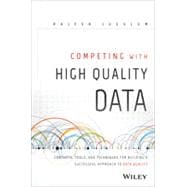Data is rapidly becoming the powerhouse of industry, but low-quality data can actually put a company at a disadvantage. To be used effectively, data must accurately reflect the real-world scenario it represents, and it must be in a form that is usable and accessible. Quality data involves asking the right questions, targeting the correct parameters, and having an effective internal management, organization, and access system. It must be relevant, complete, and correct, while falling in line with pervasive regulatory oversight programs.
Competing with High Quality Data: Concepts, Tools and Techniques for Building a Successful Approach to Data Quality takes a holistic approach to improving data quality, from collection to usage. Author Rajesh Jugulum is globally-recognized as a major voice in the data quality arena, with high-level backgrounds in international corporate finance. In the book, Jugulum provides a roadmap to data quality innovation, covering topics such as:
- The four-phase approach to data quality control
- Methodology that produces data sets for different aspects of a business
- Streamlined data quality assessment and issue resolution
- A structured, systematic, disciplined approach to effective data gathering
The book also contains real-world case studies to illustrate how companies across a broad range of sectors have employed data quality systems, whether or not they succeeded, and what lessons were learned. High-quality data increases value throughout the information supply chain, and the benefits extend to the client, employee, and shareholder. Competing with High Quality Data: Concepts, Tools and Techniques for Building a Successful Approach to Data Quality provides the information and guidance necessary to formulate and activate an effective data quality plan today.








